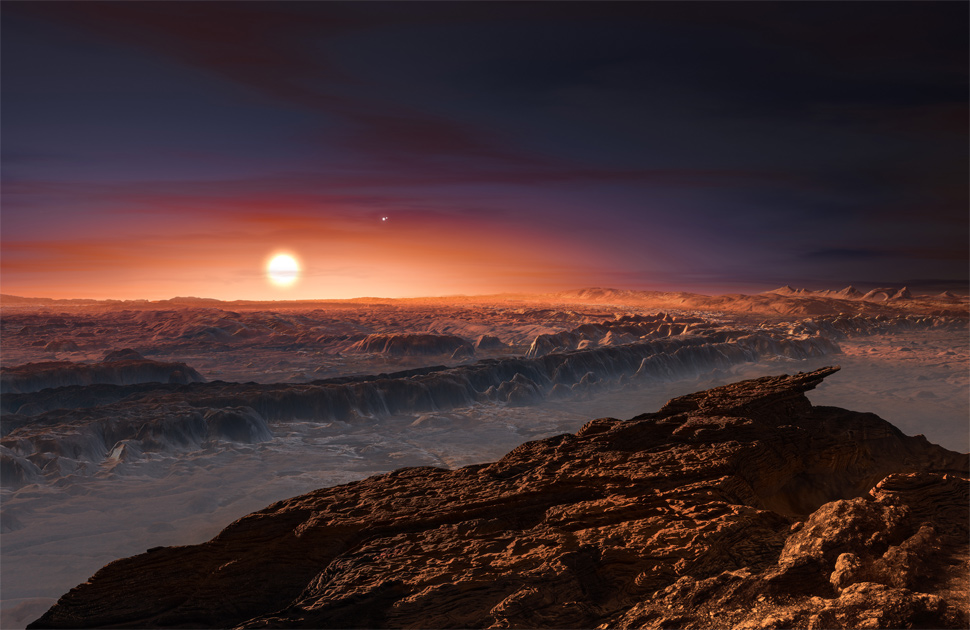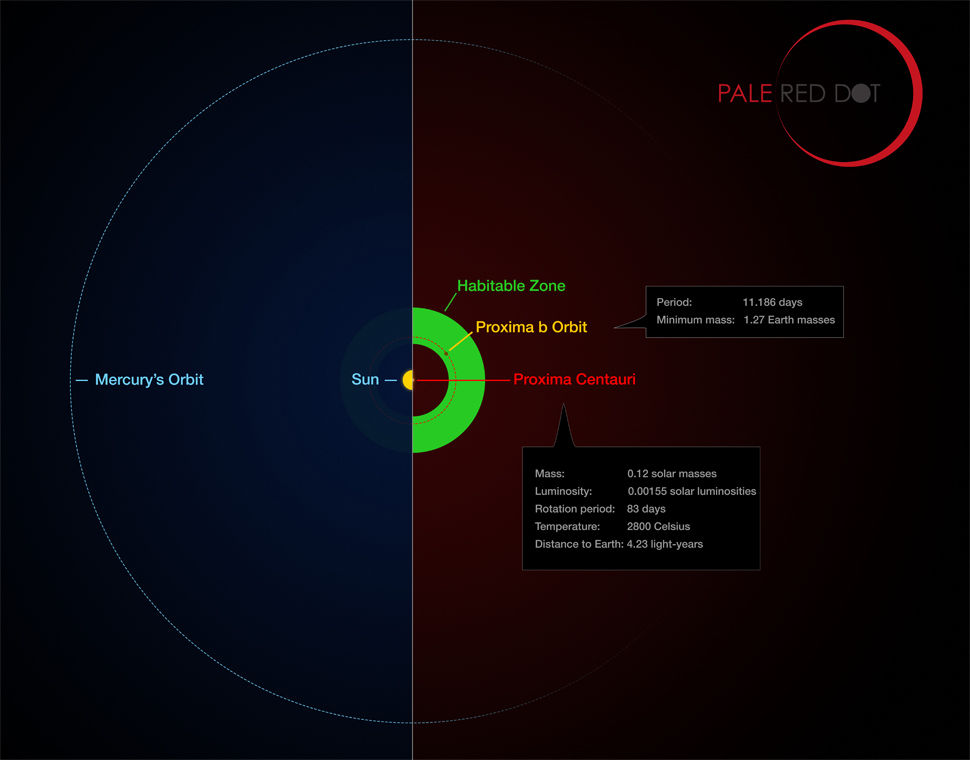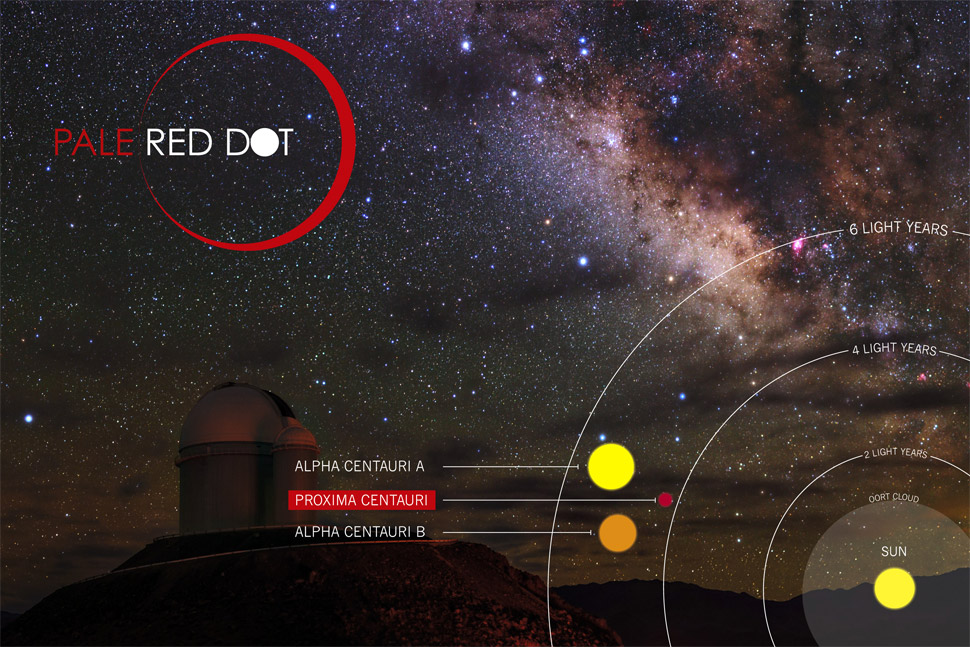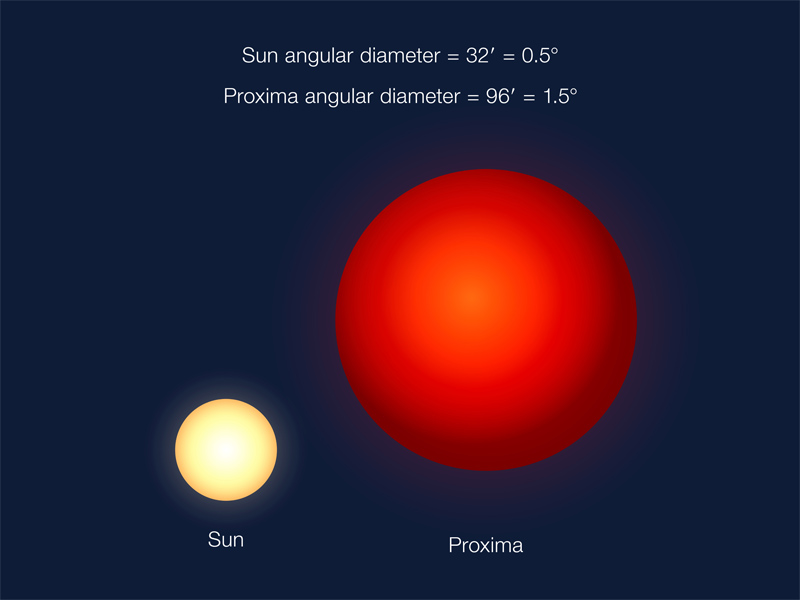
24th August 2016 Earth-mass world in habitable zone of nearest star The Pale Red Dot campaign has revealed an Earth-mass world in orbit around Proxima Centauri – the nearest star to our own.
Astronomers have today announced the detection of Proxima b – an Earth-sized exoplanet that may be located in the habitable zone of the red dwarf star Proxima Centauri, the closest star to our Sun. Due to its relative closeness, Proxima b may be visited by a fleet of interstellar StarChip probes currently being developed by the Breakthrough Starshot project. A team based at the European Southern Observatory (ESO) and other facilities found clear evidence of a planet with about 1.3 Earth masses orbiting its cool parent star every 11.2 days at a semi-major-axis distance of around 0.05 astronomical units. This makes it likely to have a temperature suitable for liquid water on its surface. The rocky world, depicted in the artist's impression above, is a little more massive than Earth and is also the closest exoplanet to us. A paper describing this milestone finding is published in the journal Nature. Despite being only 4.24 light years away (extremely close in stellar terms), Proxima Centauri is too faint to be seen with the naked eye and lies near to the much brighter pair of stars known as Alpha Centauri AB. During the first half of 2016, Proxima Centauri was regularly observed with the HARPS spectrograph on the ESO 3.6-metre telescope at La Silla in Chile, as well as simultaneously monitored by other telescopes around the globe. This was part of a campaign known as the Pale Red Dot, in which astronomers looked for the tiny back-and-forth "wobble" of the star that would be caused by the gravitational pull of an orbiting planet. Because this was a topic with very wide public interest, the progress of the campaign between mid-January and April 2016 was shared publicly as it happened on the Pale Red Dot website and via social media. The reports were accompanied by numerous outreach articles written by specialists around the world.
Lead author Guillem Anglada-Escudé, from Queen Mary University of London, explains the background to this unique search: "The first hints of a possible planet were spotted back in 2013, but the detection was not convincing. Since then, we have worked hard to get further observations off the ground with help from ESO and others. The recent Pale Red Dot campaign has been about two years in the planning." The Pale Red Dot data, when combined with earlier observations, revealed the clear signal of a truly exciting result. At times, Proxima Centauri is approaching Earth at about 5 kilometres per hour – normal human walking pace – and at times receding at the same speed. This regular pattern of changing radial velocities repeats with a period of 11.2 days. The resulting tiny Doppler shifts, analysed with extreme precision, indicated the presence of a planet with 1.3 Earth masses, orbiting 7 million kilometres from Proxima Centauri: only 5% of the Earth-Sun distance. "I kept checking the consistency of the signal every single day during the 60 nights of the Pale Red Dot campaign," said Anglada-Escudé. "The first 10 were promising, the first 20 were consistent with expectations, and at 30 days the result was pretty much definitive, so we started drafting the paper!"
Red dwarfs like Proxima Centauri are active stars and can vary in ways that would mimic the presence of a planet. To exclude this possibility, the team also monitored the changing brightness of the star extremely carefully, using the ASH2 telescope in Chile and the Las Cumbres Observatory network. Radial velocity data taken when the star was flaring were excluded from the final analysis. Although Proxima b orbits much closer to its star than Mercury does to our Sun in the Solar System, the star itself is far fainter than the Sun. Proxima b therefore lies well within the habitable zone and has an estimated surface temperature that would allow the presence of liquid water. Despite the temperate orbit of Proxima b, conditions on the surface may be strongly affected by the ultraviolet and X-ray flares from the star – far more intense than the Earth experiences. However, this would not necessarily preclude habitable conditions. If Proxima b has a strong enough magnetic field then it may be shielded from harm. Two separate papers discuss the habitability of Proxima b and its climate. The planet is close enough to its star that it might be tidally locked; a state in which a planet's orbital period and rotational period fall into sync. If the orbital eccentricity is 0, this could result in synchronous rotation with one side permanently facing towards the star, while the opposite side is permanently dark. However, between these two extreme areas, there would be a region of habitability – called the terminator line, where temperatures may be suitable (above 0°C; 32°F) for liquid water to exist. Proxima Centauri b's orbital eccentricity is not known with certainty yet, only that it is below 0.35; potentially high enough to produce a 3:2 orbit resonance similar to that which Mercury has with the Sun. The ESO predicts a far more clement environment would result from such a configuration, with average temperatures similar to those on Earth. Additionally, a much larger portion of the planet may be habitable if it supports a thick enough atmosphere to transfer heat to the side facing away from the star.
The discovery of Proxima b will lead to extensive further observations, both with current instruments and with the next generation of giant telescopes such as the European Extremely Large Telescope (E-ELT). Proxima b will be a prime target in the hunt for alien life. Indeed, the Alpha Centauri system is also the target of humankind's first attempt to explore another star system: Breakthrough StarShot. Anglada-Escudé concludes: "Many exoplanets have been found and many more will be found, but searching for the closest potential Earth-analogue and succeeding has been the experience of a lifetime for all of us. Many people's stories and efforts have converged on this discovery. The result is also a tribute to all of them. The search for life on Proxima b comes next..."
---
Comments »
|










